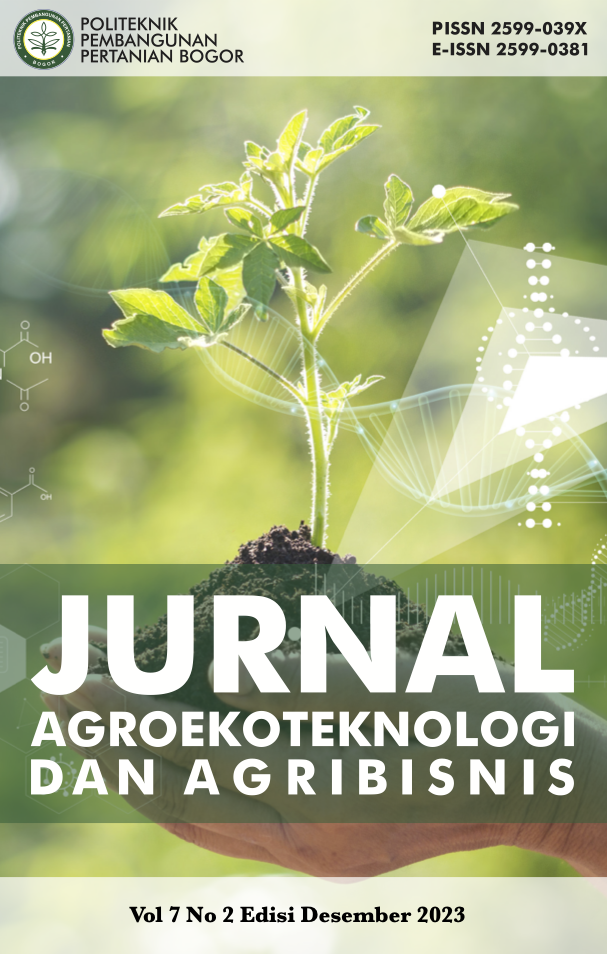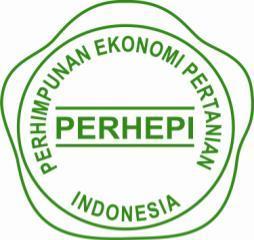Performa Produksi Ayam Broiler Menggunakan Smart Mini Closed House (Smart Pro
Production Performance of Broiler using Smart Mini Closed House (Smart Pro)
DOI:
https://doi.org/10.51852/jaa.v7i2.675Keywords:
broiler, internet of things, mini-closed house, performanceAbstract
Closed-house broiler chickens are one of the applications of technological developments in the livestock industry by providing an environment that is in accordance with what chickens need. Mini-closed houses are built so that small and medium farmers can raise broiler chickens in the closed houses at a minimum cost. The application of information system technology 4.0 (based on IoT) in mini-closed house enclosures enables farms to become smart farms (Smart Mini Closed House/Smart Pro). The purpose of this study was to compare the production performance of broiler chickens kept in a closed house without IoT and a closed house using IoT (Smart Pro). The IoT system is used to control temperature, humidity, and air quality in real time. Observations were made for eight periods, from August 2022 to March 2023. The observed data were analyzed descriptively. The results showed that broiler chickens reared on Smart Pro had a lower average feed consumption with a higher final weight, so the feed conversion value tended to be lower. There is no difference in the percentage of depletion or performance index between the two observations. The application of IoT technology in broiler rearing shows a tendency for an increase in production performance (final weight and feed conversion). However, it is necessary to adapt the use of new technology for human resources in controlling the IoT system so that it can be utilized optimally.
References
Adhistian P, Mayangsari M. 2021. Implementasi IoT dalam Otomasi Pengontrolan Kondisi Lingkungan dan Pemberian Pakan: Efeknya Terhadap Parameter Efisiensi Peternakan. Jurnal Informatika Universitas Pamulang. 6(2): 217–224.
Hariono, Afnan R, Fadilah R. 2022. The effect of wind chill in closed house on broiler performance. Jurnal Ilmu Produksi dan Teknologi Hasil Peternakan. 11(1): 34–40.
Farida TE, Hanafi ND, Tafsin M. 2022. Comparative study of broiler chicken performance in closed house and conventional system in North Sumatera. The 5th International Conference on Agriculture, Environment, and Food Security. IOP Conf. Series: Earth and Environmental Science. hlm 1–7.
Hadyanto T, Amrullah MF. 2022. Sistem monitoring suhu dan kelembaban pada kandang anak ayam broiler berbasis Internet of Things. Jurnal Teknologi dan Sistem Tertanam. 3(2) : 9–22.
Handigolkar LS, Kavya ML, Veena PD. 2016. Iot based smart poultry farming using commodity hardware and software. Bonfring International Journal of Software Engineering and Soft Computing. 6 (Special Issue): 171–175.
Husein J, Kharisma OB. 2020. Internet of things (iot) development for the chicken coop temperature and humidity monitoring system based on fuzzy. Indonesian Journal of Artificial Inteligence and Data Mining. 3(1): 1–10.
Juliasari N, Hartanto ED, Mulyati S. 2016. Monitoring suhu dan kelembaban pada mesin pembentukan embrio telur ayam berbasis mikrokontroler arduino UNO. Jurnal TICOM. 4(3): 109-113.
Leeson S, Summers JD, Caston LJ. 1992. Responses of broilers to feed restriction or diet dilution in the finisher period. Poultry Science. 71 : 2056–2064.
Lorencena MC, Southier LFP, Casanova, D, Ribeiro R, Teixeira, M. 2019. A framework for modelling, control and supervision of poultry farming. International Journal of Production Research. 58(10): 3164–3179.
Nalendra AK, Waspada HP. 2021. Penerapan artificial intelligence untuk kontrol suhu dan kelembapan pada kandang broiler berbasis internet of things. Generation Journal. 5(2): 59–68.
Oktavia H, Rochmi SE. Suprayogi TW, Legowo D. 2021. Weight gain and feed conversion of broiler chickens in reviewed from cage temperature and humidity. Journal of Applied Veterinary Science and Technology. 2 (1): 5–9.
Olanrewaju HA, Purswell JL, Collier SD, Branton SL. 2010. Effect of ambient temperature and light intensity on growth performance and carcass characteristics of heavy broiler chickens at 56 days of age. International Journal of Poultry Science. 9(8): 720-725.
Prihandanu R, Trisanto A. Yuniati Y. 2015. Model sistem kandang ayam closed house otomatis menggunakan omron sysmac CPM1A 20-CDR-A-V1. Jurnal Rekayasa dan Teknologi Elektro. 9(2): 60–81.
Qurniawan A, Arief II, Afnan R. 2016. Performans produksi ayam pedaging pada lingkungan pemeliharaan dengan ketinggian yang berbeda di Sulawesi Selatan. Jurnal Veteriner. 17(4): 622–633.
Saputra TH, Nova K, Septinova D. 2015. Pengaruh penggunaan berbagai jenis litter terhadap bobot hidup, karkas, giblet, dan lemak abdominal broiler fase finisher di closed house. Jurnal Ilmiah Peternakan Terpadu. 3(1): 38–44.
Sitaram KA, Ankush KR, Anant KN, Raghunath BR. 2018. IoT-based smart management of poultry farm and electricity generation. In: Krishnan, N, Karthikeyan, M (Eds). IEEE International Conference on Computational Intelligence and Computing Research. IEEE, hlm. 1–4.
Susanti ED, Dahlan M, Wahyuning D. 2016. Perbandingan produktivitas ayam broiler terhadap sistem kandang terbuka (open house) dan kandang tertutup (closed house) di UD Sumber Makmur Kecamatan Sumberrejo Kabupaten Bojonegoro. Jurnal Ternak. 7(1).
Zurriyati Y, Dahono. 2013. Respon fisiologis dan evaluasi karkas ayam broiler terhadap suhu pemeliharaan dingin. Seminar Nasional Teknologi Peternakan dan Veteriner. hlm 586–591.


1.png)









